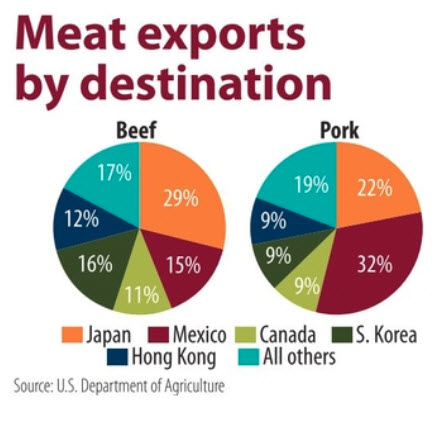Chicken Pork Beef Turkey Prices 2018
KANSAS Urban center — The composite beefiness cutout value compiled by the U.Due south. Section of Agriculture as of March 9 was upwards ten% since the first of the year and was upwardly ii% from the same date a year agone, while the pork cutout value declined half-dozen% since January. one and was downward 11% from a yr agone. At that place is no shortage of meat (red meat or poultry), and then demand is driving the market with beefiness the credible winner.
U.South. beefiness (and veal) exports were record high at 2,862 million lbs in 2017, up 12% from 2016 and the second consecutive year of double-digit growth, according to U.S.D.A. data. Shipments to Japan, the largest buyer of U.S. beef, were upwards 26% from 2016 and comprised 29% of total U.S. beef exports. Subsequently Nihon, the top foreign buyers included South korea (xvi%), United mexican states (fifteen%), Hong Kong (12%) and Canada (xi%).
The United statesD.A. on March 8 forecast 2018 U.S. beef exports at a record iii,025 meg lbs, unchanged from its February forecast, which was up 40 1000000 lbs from January and upwardly 163 million lbs, or half-dozen%, from 2017, "based on continuing strong need in overseas markets and the weakening of the U.S. dollar," forth with "continued tightness of beef availability from Oceania."
At the same time, U.Southward. beef supplies continue to increase but at a slower stride. The U.S.D.A. in its semi-annual Cattle Inventory written report showed full Jan. ane cattle numbers at 94.4 one thousand thousand caput, up 0.vii% from a yr earlier and compared with increases of 1.9% on Jan. ane, 2017, 3.ane% in 2016 and 0.7% in 2015, which was up from a 2014 inventory that was the lowest since 1951. The study also showed 237,000 fewer beef heifers were retained than a year earlier, which indicated the four-year herd expansion was slowing.
 Too affecting beef supplies this twelvemonth is the drought across the southern Plains, which has reduced pasture and wheat grazing and resulted in the motion of more cattle at lighter weights into feedlots in belatedly 2017 than average. Since those cattle will be on feed longer, offset-quarter marketings are expected to pass up, but second-quarter sales likely will increase, somewhat shifting the normal menses of beef to the market. Beef production for all of 2018 is forecast to be upward half-dozen% from 2017.
Too affecting beef supplies this twelvemonth is the drought across the southern Plains, which has reduced pasture and wheat grazing and resulted in the motion of more cattle at lighter weights into feedlots in belatedly 2017 than average. Since those cattle will be on feed longer, offset-quarter marketings are expected to pass up, but second-quarter sales likely will increase, somewhat shifting the normal menses of beef to the market. Beef production for all of 2018 is forecast to be upward half-dozen% from 2017.
For pork, the demand picture remains stiff, only rising production appears to be keeping a lid on prices. In March the U.S.D.A. boosted forecast production in 2018 past 25 million lbs from February, with outturn for the year expected to increment 5% from 2017. The United states of americaD.A. based the March increase on heavier slaughter weights, which more than commencement fewer hogs marketed. The U.S.D.A. attributed the increase to still moderate feed costs (though rising), favorable wintertime weather in major producing areas and positive producer returns. The U.Southward.D.A. said in February that college grunter prices may have been more than the result of expanded packer slaughter capacity equally it wasn't articulate if consumer demand for pork was keeping pace with production increases.
 Like beef, pork exports also have been strong. Exports in 2017 equated to 22% of U.South. pork production (compared to xi% for beef) and are expected to increment 6% in 2018 (maintaining a 22% share of production). Expected lower pork prices in 2018 are seen as an incentive for increased exports. Mexico is past far the largest buyer of U.S. pork, taking 32% of total U.South. pork exports in 2017, followed by Nihon at 22% and Canada, Southward Korea and Prc/Hong Kong at simply over 9% each.
Like beef, pork exports also have been strong. Exports in 2017 equated to 22% of U.South. pork production (compared to xi% for beef) and are expected to increment 6% in 2018 (maintaining a 22% share of production). Expected lower pork prices in 2018 are seen as an incentive for increased exports. Mexico is past far the largest buyer of U.S. pork, taking 32% of total U.South. pork exports in 2017, followed by Nihon at 22% and Canada, Southward Korea and Prc/Hong Kong at simply over 9% each.
Stocks of meat in freezers, which are just one indication of demand, varied widely betwixt beefiness, pork and poultry as of Jan. 31 (the latest data bachelor). Frozen beef stocks at 499,554,000 lbs were downward 7% from a tape high a yr earlier. Pork stocks at 567,984,000 lbs were up 8% from 2017 (record loftier in January 2016), and total poultry stocks at ane,252 1000000 lbs were record high as of Jan. 31 this year, although neither chicken or turkey were at record levels individually. Sharply higher pork belly stocks (the raw textile for bacon), which on Jan. 31 were upwardly 219% from record lows a year earlier, and lower belly prices and so far this yr were seen as major factors in pulling down the overall pork carcass cutout value.
Other factors also will bear on meat and poultry production, exports and supply in the coming months, including feed prices (corn values continue to rise on strong export demand and weather woes in Argentina), weather and trade problems, the latter of which remain unpredictable.
Source: https://www.foodbusinessnews.net/articles/11492-strong-demand-driving-beef-prices-higher
0 Response to "Chicken Pork Beef Turkey Prices 2018"
Postar um comentário